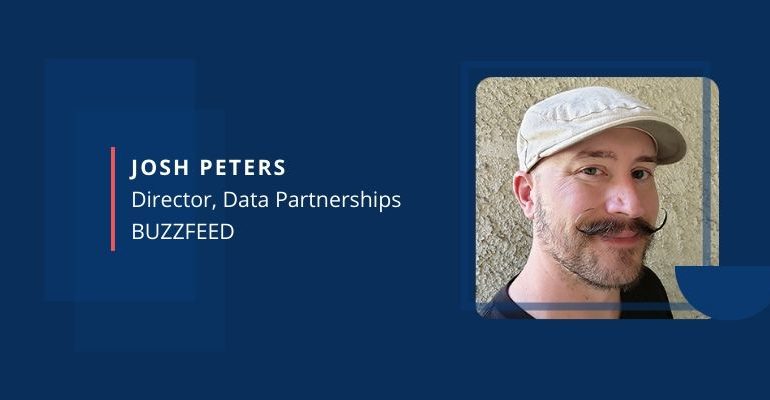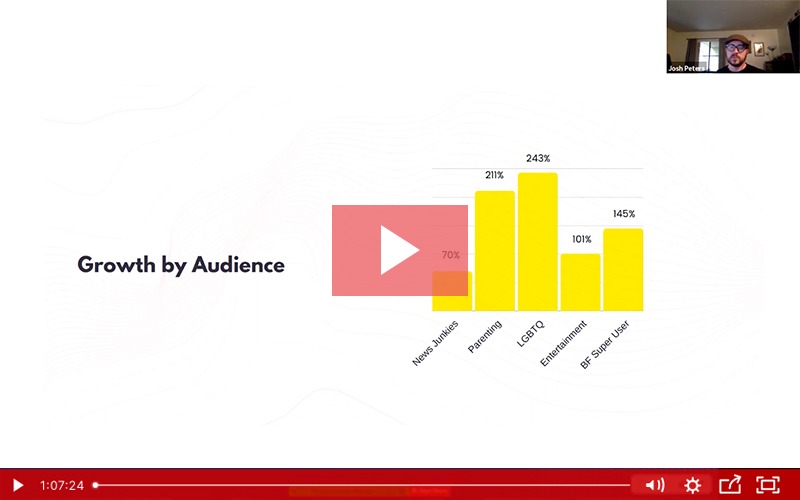Change might be the only constant when it comes to digital advertising. The industry is now embracing newer methods of tracking user data for serving ads. Publishers are shifting focus towards their most valuable resource: first party data. To understand how leading publishers are adapting to this change, we conducted a webinar with Josh Peters, Director of Data Partnerships at BuzzFeed.
First-party data is user information that is collected from the source domain. With privacy laws such as the GDPR and the CCPA in place, publishers are now focusing on this data. The primary reason for this development is consumers feeling more secure in sharing information with brands they trust. For example, in a survey conducted by eMarketer, 80.1% of the respondents were comfortable with brands using their personal information for personalized targeting.
Also Read: First-Party vs. Third-Party Cookies: What’s the Difference?
During the course of this webinar, Josh shed light on how BuzzFeed began scaling their first-party data collection by audience segmentation, analysis, and finding the right data management platform (DMP).
For two years, Josh and his team started analyzing audience data from lost deals. They tried to find any addressable trends that had potential for growth. These were related to:
- Ingestion of client data
- Ingestion of data from second and third parties
- Data exporting abilities
- Campaign analysis
- Customization of data offering for clients
Following this, Josh and his team conducted discussions with the tech team to review the data management process at BuzzFeed.
They found out that the biggest hurdle was DMP management. In order to find the right platform for managing and scaling audience data, BuzzFeed conducted a lengthy process of interviewing and scoring various DMPs and even Customer Data Platforms. And that has been the deciding factor for them to scale their revenue using first-party data management.
Additionally, Josh stressed on the fact that resolving technical challenges wasn’t the only significant factor. Collaboration with teams, giving them a chance to get acquainted with the new technology, and working in a cross-functional manner were other important aspects of BuzzFeed’s success.
Important Insights from the Webinar Polls
- 61% of the participants already use audience identification and segmentation
- 22% of the participants hadn’t delved in audience segmentation and didn’t intend to
- 17% of participants were convinced from the webinar to start audience segmentation
- 50% of participants have still not started aligning their business goals with first-party data
- 29% of participants have actively started embracing first-party data
Key Takeaways
Josh had a lot of actionable insights for publishers on getting started with the first-party data model. As mentioned before, Josh and his team focused on finding the right tech for managing first-party data and making sure that all teams worked in sync to attain maximum growth. Here are key takeaways from our conversation with him:
Identify Pain Points
He recommended that publishers should put aside some time to analyze their business and recognize the barriers that are holding them back from growing. He added that this should be a recurring step as pain points will continue emerging in a business model.
Analyze Solutions
There isn’t always a specific solution to any issue. Sometimes onboarding new tech can be the deciding factor, other times hiring new people can help improve. This is why it’s important to consistently also analyze solutions for their impact.
Involve In-house Teams
Josh believes that this might be the most important point that publishers should focus on. A cross-functional team always helps in gathering better insights and scaling your revenue model. The earlier the publisher involves their in-house teams or outsource important tasks, the better the results shall be. This helps in-house teams in adapting to the changes and come up with effective solutions.
Test and Repeat
If any solution is both expensive and time-consuming, it’s always better to test it on a smaller scale. Once their prospective solution is tested on the small scale, they can gradually move on to implementing it company-wide. Publishers who do this experience low financial loss later.
Important Questions Asked
Towards the end of the webinar, we also had a Q&A session in which our participants asked Josh a few questions on scaling first-party data. Here are the top questions according to us:
- Should publishers also be looking at Customer Data Platforms as opposed to DMPs for first-party data?
Josh answered this by stating that choosing between CDPs and DMPs is dependent on the kind of data that is being collected. For example, if publishers ask users to enter their email IDs for gated content, then using CDPs make sense. However, for publishers like BuzzFeed where content is generally free and accessible for all users, accumulated data is easily manageable by a DMP.
- What’s the easiest way to collect first-party data and does it really cost a lot?
Josh believes that the cost of collecting first-party data is relative to a publisher’s expectations for scaling and the tech that they employ. Probably the most rudimentary way of doing that is by using Google Analytics which is cost-effective. But better scaling demands an expensive and customized data management solution.
You can view the webinar recording here: Publisher 1st Party Data: From Striving to Thriving

Shubham is a digital marketer with rich experience working in the advertisement technology industry. He has vast experience in the programmatic industry, driving business strategy and scaling functions including but not limited to growth and marketing, Operations, process optimization, and Sales.




![Top 12 Ad Networks in India Every Publisher Should Know [2024 Edition] Indian Ad Networks](https://www.adpushup.com/blog/wp-content/uploads/2019/09/undraw_Note_list_re_r4u9-270x180.png)



